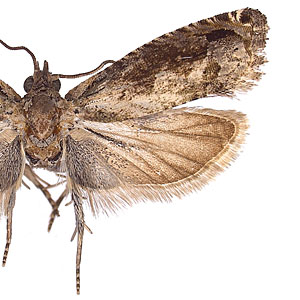Overview

The genus Crocidosema contains approximately 30 described species. Most species diversity occurs in the neotropics. Adults are brown or gray and wing patterns are typical of many Eucosmini, with numerous white costal strigulae and a well-defined ocellus. Male genitalia are characterized by large socii, a short uncus, and variably shaped valvae. Female genitalia are characterized by a pair of pockets or lobes on sternum VII and two signa in the corpus bursae.
One species, C. plebejana, is cosmopolitan and occurs in Europe, northern Africa, Asia, Australia, North America, Central America, and South America. Larvae feed primarily on plants in the Malvaceae, and in some areas are a pest of cotton. Crocidosema aporema is distributed from south Texas through Central and South America south to Argentina and Chile. It is a major pest of beans (Glycine max and Phaseolus) in Central and South America, but has not been reported to cause economic damage in the U.S.
Larvae of C. aporema are frequently intercepted at U.S. ports of entry on beans originating from Central America, South America, or the Carribean.
Target species
Crocidosema aporema
Non-target species
Crocidosema plebejana
References

Arneodo, J., G. Quintana and A. Sciocco-Cap. 2010. Biology and morphometrics of the immature stages of Epinotia aporema on artificial diet. Pesquisa Agropecuaria Brasileira. 45: 221-223.
Bishop, A. L. and P. R. B. Blood. 1978. Temporal distribution, biology and life history of the cotton tipworm, Crocidosema plebiana [sic] Zeller, on cotton in the south-eastern Queensland region. Australian Journal of Zoology. 26: 147-152.
Horak, M. 2006. Olethreutine moths of Australia (Lepidoptera: Tortricidae). Monographs on Australian Lepidoptera, Vol. 10. 522 pp.

